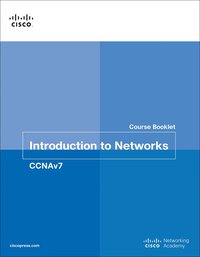
- Format
- Häftad (Paperback)
- Språk
- Engelska
- Antal sidor
- 288
- Utgivningsdatum
- 2017-01-26
- Upplaga
- 1
- Förlag
- Cisco Press
- Dimensioner
- 272 x 213 x 20 mm
- Vikt
- Antal komponenter
- 1
- Komponenter
- Paperback (1)
- ISBN
- 9781587133596
- 613 g
Introduction to Networks v6 Course Booklet
Kundrecensioner
Fler böcker av Cisco Networking Academy
-
Enterprise Networking, Security, and Automation Companion Guide (CCNAv7)
Cisco Networking Academy
-
Introduction to Networks Companion Guide (CCNAv7)
Cisco Networking Academy
-
Routing and Switching Essentials v6 Companion Guide
Cisco Networking Academy
-
Switching, Routing, and Wireless Essentials Companion Guide (CCNAv7)
Cisco Networking Academy
Övrig information
Cisco Networking Academy teaches hundreds of thousands of students annually the skills needed to build, design, and maintain networks, improving their career prospects while filling the global demand for networking professionals. With 10,000 academies in 165 countries, it helps individuals prepare for industry-recognized certifications and entry-level information and communication technology careers in virtually every industry-developing foundational technical skills while acquiring vital 21st-century career skills in problem solving, collaboration, and critical thinking. Cisco Networking Academy uses a public-private partnership model to create the "world's largest classroom."
Innehållsförteckning
Chapter 0 Course Introduction 1 0.0 Welcome to Introduction to Networks 1 0.0.1 Message to the Student 1 0.0.1.1 Welcome 1 0.0.1.2 A Global Community 1 0.0.1.3 More Than Just Information 1 0.0.1.4 How We Teach 2 0.0.1.5 Practice Leads to Mastery 2 0.0.1.6 Mind Wide Open 2 0.0.1.7 Engineering Journals 2 0.0.1.8 Explore the World of Networking 2 0.0.1.9 Create Your Own Worlds 3 0.0.1.10 How Packet Tracer Helps Master Concepts 3 0.0.1.11 Course Overview 3 Chapter 1 Explore the Network 5 1.0 Introduction 5 1.0.1.1 Exploring the Network 5 1.0.1.2 Class Activity - Draw Your Concept of the Internet 5 1.1 Globally Connected 6 1.1.1 Networking Today 6 1.1.1.1 Networks in Our Daily Lives 6 1.1.1.2 Technology Then and Now 6 1.1.1.3 No Boundaries 6 1.1.1.4 Networks Support the Way We Learn 7 1.1.1.5 Networks Support the Way We Communicate 7 1.1.1.6 Networks Support the Way We Work 8 1.1.1.7 Networks Support the Way We Play 8 1.1.1.8 Lab - Researching Network Collaboration Tools 8 1.1.2 Providing Resources in a Network 9 1.1.2.1 Networks of Many Sizes 9 1.1.2.2 Clients and Servers 9 1.1.2.3 Peer-to-Peer 9 1.2 LANs, WANs, and the Internet 10 1.2.1 Network Components 10 1.2.1.1 Overview of Network Components 10 1.2.1.2 End Devices 10 1.2.1.3 Intermediary Network Devices 10 1.2.1.4 Network Media 11 1.2.1.5 Network Representations 11 1.2.1.6 Topology Diagrams 11 1.2.1.7 Activity - Network Component Representations and Functions 12 1.2.2 LANs and WANs 12 1.2.2.1 Types of Networks 12 1.2.2.2 Local Area Networks 12 1.2.2.3 Wide Area Networks 13 1.2.3 The Internet, Intranets, and Extranets 13 1.2.3.1 The Internet 13 1.2.3.2 Intranets and Extranets 13 1.2.4 Internet Connections 14 1.2.4.1 Internet Access Technologies 14 1.2.4.2 Home and Small Office Internet Connections 14 1.2.4.3 Businesses Internet Connections 15 1.2.4.4 Packet Tracer - Help and Navigation Tips 15 1.2.4.5 Packet Tracer - Network Representation 15 1.3 The Network as a Platform 16 1.3.1 Converged Networks 16 1.3.1.1 Traditional Separate Networks 16 1.3.1.2 The Converging Network 16 1.3.1.3 Lab - Researching Converged Network Services 16 1.3.2 Reliable Network 16 1.3.2.1 Network Architecture 16 1.3.2.2 Fault Tolerance 17 1.3.2.3 Scalability 17 1.3.2.4 Quality of Service 17 1.3.2.5 Security 18 1.3.2.6 Activity - Reliable Networks 18 1.4 The Changing Network Environment 18 1.4.1 Network Trends 18 1.4.1.1 New Trends 18 1.4.1.2 Bring Your Own Device 19 1.4.1.3 Online Collaboration 19 1.4.1.4 Video Communication 19 1.4.1.5 Cloud Computing 20 1.4.2 Networking Technologies for the Home 20 1.4.2.1 Technology Trends in the Home 20 1.4.2.2 Powerline Networking 20 1.4.2.3 Wireless Broadband 21 1.4.3 Network Security 21 1.4.3.1 Security Threats 21 1.4.3.2 Security Solutions 22 1.4.3.3 Activity - Network Security Terminology 23 1.4.4 Network Architecture 23 1.4.4.1 Cisco Network Architecture 23 1.4.4.2 CCNA 24 1.4.4.3 Lab - Researching IT and Networking Job Opportunities 24 1.5 Summary 24 1.5.1 Conclusion 24 1.5.1.1 Class Activity - Draw Your Concept of the Internet Now 24 1.5.1.2 Warriors of the Net 25 1.5.1.3 Exploring the Network 25 Chapter 2 Configure a Network Operating System 27 2.0 Introduction 27 2.0.1.1 Configure a Ne
